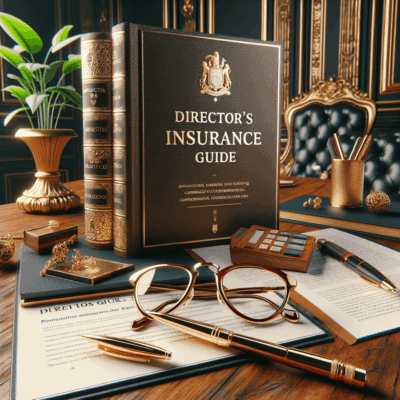Understanding the Critical Role of Directors Insurance Coverage
In the complex and often litigious landscape of modern business, the individuals at the helm—the directors and officers—navigate a minefield of potential risks. Every strategic decision, from mergers and acquisitions to daily operational management, carries inherent liability. A single lawsuit, whether from shareholders, employees, regulators, or competitors, can not only threaten the financial stability of the company but also the personal assets of its leadership. This is where Directors and Officers (D&O) insurance becomes not just a prudent investment, but an essential component of sound corporate governance. This comprehensive guide will delve into the intricacies of directors insurance coverage, underscoring its importance, dissecting its structure, and providing a framework to compare insurance policies effectively to secure the most robust protection for your organization’s leaders.
What is Directors and Officers (D&O) Insurance?
At its core, D&O insurance is a liability policy designed to protect the personal assets of a company’s directors, officers, and, in some cases, employees, in the event they are sued for alleged wrongful acts while managing the company. These “wrongful acts” can include actual or alleged errors, omissions, misleading statements, neglect, breach of duty, or other acts of mismanagement.
A common misconception is that a corporation’s structure inherently shields its leaders from personal financial loss. While incorporation does provide a degree of protection, it is not an impenetrable barrier. Plaintiffs’ attorneys will often name individual directors and officers in lawsuits, personally targeting them. Without adequate D&O coverage, these individuals could be forced to pay for their own legal defense, settlements, or judgments—a prospect that could lead to personal bankruptcy and makes attracting top-tier talent to a board nearly impossible.
D&O insurance exists to mitigate this threat. It serves three primary purposes:
- Protecting Personal Assets: It shields the personal wealth—homes, savings, investments—of directors and officers.
- Attracting and Retaining Talent: A robust D&O policy is a key tool for recruiting high-caliber individuals to leadership positions, as it demonstrates the company’s commitment to protecting them.
- Protecting Corporate Balance Sheets: The policy can reimburse the company if it is required to indemnify its leaders, thereby preventing a significant financial hit from a lawsuit from destabilizing the organization.
The Three Sides of the Shield: Deconstructing D&O Policy Structure
D&O insurance policies are typically structured in three parts, commonly referred to as “Sides.” Understanding this structure is the first critical step to effectively compare insurance offerings.
Side A: Direct Coverage for Individuals
This component provides direct coverage to the directors and officers themselves when the company is legally unable to indemnify them. This is the most crucial layer of protection, as it is the last line of defense for personal assets. Scenarios triggering Side A coverage include:
- The company is legally prohibited from indemnifying its leaders (e.g., due to bankruptcy or insolvency).
- State law or the company’s charter does not permit indemnification for a specific claim.
- The company simply refuses to indemnify them, though this is rare.
Side B: Corporate Reimbursement
This is the most frequently used part of a D&O policy. When the company does indemnify its directors and officers for a loss (as it is typically obligated to do), Side B reimburses the corporation for those expens
es. This protects the company’s financial health by ensuring that a legal claim doesn’t decimate its operating capital or reserves.
Side C: Entity Securities Coverage
Often referred to as “entity coverage,” Side C extends protection to the organization itself for securities claims. This is particularly relevant for publicly traded companies that may face lawsuits directly targeting the corporate entity in relation to its stock performance, mergers, or other securities-related activities. For private companies, this coverage is often narrower or may be excluded.
Why is D&O Insurance Non-Negotiable in Today’s Environment?
The risk landscape for directors and officers has expanded dramatically, moving far beyond the traditional domain of shareholder disputes.
- Shareholder Lawsuits: Allegations of mismanagement, failure to maximize shareholder value, or misleading financial statements remain a primary driver of claims.
- Regulatory Investigations: Agencies like the SEC (Securities and Exchange Commission), DOJ (Department of Justice), and EPA (Environmental Protection Agency) can launch costly investigations and proceedings against individuals.
- Employment Practices Liability: Claims from employees for wrongful termination, discrimination, harassment, or retaliation are increasingly common and frequently name leadership.
- Cyber Liability and Data Breaches: As cyber threats grow, directors and officers are being held accountable for allegedly failing to implement adequate security measures, leading to data breaches.
- Mergers & Acquisitions (M&A): Transactions often spark litigation from shareholders who believe the deal is unfavorable, alleging conflicts of interest or a flawed sales process.
- Stakeholder Activism: Creditors, customers, and competitors can also initiate litigation, broadening the pool of potential plaintiffs.
Given this expansive threat matrix, for-profit corporations, non-profits, and private companies of all sizes must view D&O insurance as a fundamental aspect of their risk management strategy. Don’t skimp here when you are looking at overall company protection otherwise you will regret it should the worst happen.
How to Critically Compare Insurance Policies: A Buyer’s Checklist
Not all D&O policies are created equal. The specific terms, conditions, exclusions, and limits can vary significantly between carriers. A thorough and impartial comparison is essential to secure the right coverage. Here is a detailed checklist to guide your evaluation:
1. Policy Limits and Deductibles
- Adequate Limits: Do not base your limit decision solely on company size. Consider industry risk, volatility, and the potential cost of defense in your sector. A $5 million claim can easily bankrupt a mid-sized company and its leaders.
- Structure of Limits: Is the limit “wasting” (defense costs erode the limit) or “non-wasting” (defense costs are outside the limit)? Non-wasting is superior but more expensive.
- Deductibles/Retentions: Understand the amount the company must pay out-of-pocket before the policy responds. Compare the retention amounts across quotes.
2. Scope of Coverage
- Definition of “Wrongful Act”: This is the heart of the policy. Scrutinize how broadly or narrowly it is defined.
- Claim Definition: How does the policy define a “claim”? Does it include informal investigations, subpoenas, and Wells notices (notices from the SEC indicating a likely enforcement action)?
- Entity Coverage: Does the policy include Side C coverage? If so, for what types of claims?
- Outside Entity Coverage: Are directors and officers covered for serving on
- the board of a subsidiary or another non-profit (if allowed by the company)?
3. Key Exclusions
Exclusions are where policies truly differ. An impartial broker can be invaluable in explaining the real-world impact of these clauses.
- Fraud/Dishonesty: Standard exclusion for proven fraudulent or criminal acts. Ensure it is based on a “final adjudication,” meaning the exclusion only applies after a court has definitively found the individual guilty.
- Personal Profit: Exclusion for acts where the individual gained an illegal personal profit or advantage.
- Bodily Injury/Property Damage: Typically excluded (this is covered under General Liability insurance).
- Pollution: Often excluded, though buy-backs may be available.
- Prior Acts: Understand what past acts are covered. “Full prior acts” coverage is ideal if switching carriers.
- Insured vs. Insured: Excludes claims brought by one insured person against another (e.g., a current director suing a former officer). This exclusion has nuances; some carve-backs may allow for claims brought in bankruptcy or by whistleblowers.
4. Defense Provisions
- Selection of Counsel: Does the insurer have the right to choose the law firm, or does the insured company retain control? The ability to choose your own counsel is a significant advantage.
- Consent to Settle: Does the policy require the insurer to obtain your consent before settling a claim? This is a critical right to maintain.
5. Carrier Financial Strength and Reputation
- Ratings: Check the financial strength ratings of the insurance carrier from agencies like A.M. Best, Standard & Poor’s, and Moody’s. You need a carrier that will be solvent and reliable when a claim arises years down the line.
- Claims Handling Reputation: Research or ask your broker about the insurer’s reputation for handling claims fairly and efficiently. A smooth claims process is paramount during a crisis.
The Role of an Impartial Advisor in the Process
Navigating the D&O market is complex. An experienced, impartial insurance broker specializing in executive risk is arguably your most valuable asset. Their role is to:
- Conduct a thorough risk assessment of your organization.
- Provide market insight and access to a wide range of A-rated carriers.
- Demystify policy language and explain the practical implications of different terms.
- Present an objective, apples-to-apples analysis of multiple quotes to help you compare insurance options effectively.
- Negotiate with insurers on your behalf to secure the broadest terms at the most competitive price.
- Advocate for you in the event of a claim.
A broker’s duty is to you, the client, not the insurance company. Their impartial guidance ensures your organization’s unique risks are matched with the most appropriate coverage solution.
Conclusion: An Investment in Leadership and Stability
Directors insurance coverage is far more than a line item on a budget; it is a fundamental pillar of corporate resilience and ethical leadership. It empowers directors and officers to make bold, strategic decisions necessary for growth without the paralyzing fear of personal financial ruin. It assures stakeholders that the company is governed with foresight and responsibility. In a world where litigation is an ever-present threat, a well-structured D&O policy provides the security that allows talent to lead, companies to innovate, and boards to govern effectively. By taking a meticulous, informed approach to understand a
Frequently Asked Questions
Q: What is directors insurance coverage?
A: Directors insurance, also known as Directors and Officers (D&O) Liability Insurance, is a policy that protects the personal assets of a company’s directors and officers if they are personally sued for alleged wrongful acts while managing the organization.
Q: What does directors insurance typically cover?
A: It typically covers legal fees, settlements, and financial losses resulting from claims of mismanagement, breaches of fiduciary duty, negligence, errors in judgment, and employment practice violations.
Q: Who needs directors insurance?
A: Any company with a board of directors or officers should consider this coverage. It is crucial for public companies, non-profits, and private companies of all sizes, as it helps attract and retain qualified leadership by protecting their personal wealth.
Q: What is not covered by a standard D&O policy?
A: Standard policies typically exclude fraudulent, criminal, or intentionally illegal acts, personal profiting to which the executive was not legally entitled, bodily injury/property damage (covered by other insurance like General Liability), and lawsuits already in progress when the policy is purchased.





